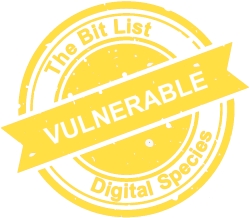Current Hard Disk Technologies
 |
||
|
Materials saved to storage devices with a variety of underlying magnetic or solid-state (flash) technologies that are hardwired into a computer still under warranty or supported: typically hard disks that are less than five years old. |
||
|
Digital Species: Integrated Storage |
Trend in 2022:
|
Consensus Decision |
|
Added to List: 2019 |
Trend in 2023:
|
Previously: Vulnerable |
|
Imminence of Action Action is recommended within five years, detailed assessment within three years. |
Significance of Loss The loss of tools, data or services within this group would impact on many people and sectors. |
Effort to Preserve | Inevitability Loss of material in this group could be entirely avoidable if provided the means to deploy proven tools and techniques. |
|
Examples Direct Attached Storage (DAS) such as magnetic or solid-state drives integrated into individual laptops or workstations and into smaller scale storage facilities. |
||
|
‘Endangered’ in the Presence of Aggravating Conditions Encryption; poor handling; poor storage; lack of consistent replication; failure of external (dependencies, e.g., suppliers, security); political or commercial interference; failure of internal dependencies (e.g., power supply, disk controller); overly aggressive compression; poor information security; lack of integrity-checking; lack of strategic investment; lack of warranty; unenforceable warranty. |
||
|
‘Lower Risk’ in the Presence of Good Practice Backup to different technology; backup to diverse locations; documentation of assets; integrity checking; preservation planning; refreshment planning; export functionality; resilient to hacking; selection and appraisal criteria; version control; resilient funding; technology watch; enforceable warranty; disaster planning. |
||
|
2023 Review This entry was added in 2019 to ensure that the range of media storage is properly assessed and presented. It was reviewed in 2021 with a noted trend towards greater risk in light of the continued shift towards reliance on cloud storage with computers increasingly reducing hard disk for solid-state storage and commercial motivations for less support, and reviewed in 2022 with no noted increase in trend towards even greater or reduced risk. The 2023 Council agreed with the current Vulnerable classification, with overall risks remaining on the same basis as before (no change to the trend), while also noting a slight decrease in the effort needed to preserve and the imminence of action required when compared to the 2021 Jury review. |
||
|
Additional Comments As people increasingly select other storage methods, such as cloud, they are less likely to maintain existing content on portable hard disks, which means the portable hard disks are more likely to be overlooked or ignored (e.g., left in drawers) rather than checked and refreshed. There are also indications of increasing prevalence of soldered-in flash storage which cannot easily be accessed in the case of device failure. Case Studies or Examples:
See also:
|
||






























































































































